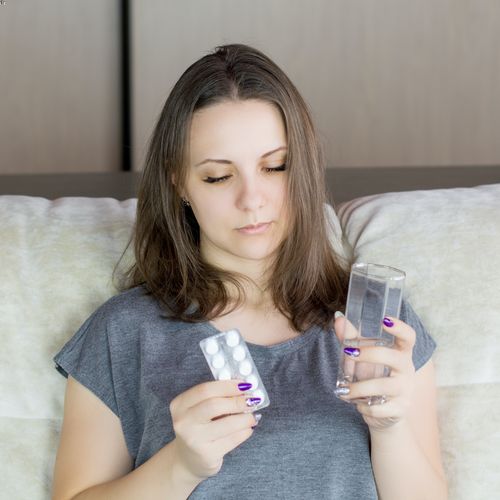Should You Be Concerned About Your Painful Ovulation?
Many women expect the monthly hassle of symptoms related to our period. While we know that the bloating, cramping, headaches and food cravings are par for the course, what about mid-cycle pain? About 20 percent of women experience painful ovulation midway through their cycle each month. The good news is mid-cycle ovulation is rarely a concern.
Painful mid-cycle ovulation is referred to as Mittelschmerz which is German for “middle pain”. If you are not sure if you have Mittelschmerz it is typically described as a sharp ache or biting pain that reduces gradually over the next few hours. The pain can also be accompanied by cramps, spotting, and nausea. Some women’s Mittelschmerz is more severe and can be quite disruptive. Sometimes these symptoms can be mistaken for appendicitis.
If your painful ovulation only occurs occasionally, this is a normal trait of Mittelschmerz. Some women experience painful ovulation every month, but most women only experience it every 3-4 months. The symptoms can occur on both sides of your abdomen, but is typically more prevalent on the right side. Your symptoms may flare up when you are working out or having intercourse. Frequent urination and diarrhoea or constipation may accompany your Mittelschmerz. You should be feeling better within 6-8 hours after your mid-cycle Mittelschmerz begins—for some women it takes up to a full day to disappear.
Why Does Painful Ovulation Occur?
If you are wondering why this painful ovulation occurs you are not alone. During ovulation our ovaries sometimes release a small amount of blood. While this is not a concern, our body has to reabsorb the excess blood. The process of absorbing the blood causes the symptoms associated with Mittelschmerz. The more severe your symptoms, the more blood your body has released and is reabsorbing. Mittelschmerz does not lead to any serious health conditions, but its symptoms are similar to other medical conditions such as PCOS and fibroids.
To ensure that your symptoms are Mittelschmerz consult with your medical professional.
How Does Ovulation Pain Feel?
The experience of ovulation pain can vary from woman to woman. Based on anecdotal evidence we can see some common symptoms:
- The pain is usually felt on one side of the abdomen.
- From cycle to cycle the pain may randomly alternate from one side to another. This is because ovulation take place on a random side with each cycle.
- Many women report a dull ovulation pain that can last for a few minutes, up to many hours. Other women suggest that the pain can be sharp, sudden and over in seconds.
- Most of the time, the pain is mild but it can often be sometimes incorrectly mistaken as appendicitis.
How Is Painful Ovulation Diagnosed?
If you think that the symptoms you are experiencing may be Mittelschmerz it is still a good idea to consult with your medical professional. Your physician will determine if your painful ovulation is Mittelschmerz by assessing what time in your cycle your symptoms occur. To assist your physician it is helpful if you document when your painful ovulation occurs and the frequency of your menstrual cycle.
Most of the time Mittelschmerz can be diagnosed without any tests or procedures. If your physician is not able to confirm that your symptoms are Mittelschmerz they may opt to perform a laparoscopic procedure. This would be a minimally invasive procedure that will allow a clear view of your reproductive and pelvic organs. You may also need to have other tests and blood work done to properly diagnose your symptoms.
If the discomfort of painful ovulation is causing anxiety in your life, make sure to take your time in getting a clear diagnosis. There is no need to rush into unnecessary medical procedures.
How to Cope With Ovulation Pain
Coping with ovulation pain is similar to coping with painful period pain. You should be able to cope with ovulation pain in the same way you might handle period cramps. Ibuprofen, hot water bottles, drinking lots of water, and seeing your way through it, all of these methods will help you get through the worst.
Understanding the physiology behind ovulation can be helpful for managing the associated pain. When the ovary releases an egg mid-cycle, and the uterus prepares for potential pregnancy, increased activity in these organs can lead to cramping.
There are some beneficial approaches to consider. Adequate rest is paramount, as lack of sleep tends to exacerbate menstrual discomfort. Practicing relaxation techniques, such as deep breathing, yoga or meditation, can also provide relief.
Getting exercise in the days leading up to ovulation may additionally help by relaxing muscles, regulating hormones, and reducing stress. Discuss appropriate exercises with your doctor. When the body is well-conditioned, ovulation pain may be less pronounced.
For severe pain unresponsive to other measures, your physician may recommend a hormonal contraceptive to halt ovulation. This can prevent ovulation pain while regulating the menstrual cycle.
While challenging to endure, self-care strategies of rest, relaxation, and exercise may make ovulation pain more tolerable. Allotting time for such practices around ovulation could diminish symptoms. Confer with your doctor as needed about further management options. With the right approach, it may be possible to achieve a more comfortable ovulation experience.
When to See a Doctor
While mittelschmerz is generally harmless, severe or worsening ovulation pain may be a sign of an underlying gynecological condition. It’s important to monitor your symptoms and see your doctor if you experience any of the following:
- Ovulation pain that is getting progressively worse each month
- Ovulation pain that lasts longer than 24 hours
- Ovulation pain along with unusual vaginal discharge or fever
- Ovulation pain that prevents you from doing your normal daily activities
- Ovulation pain accompanied by nausea, vomiting or fainting
- Irregular ovulation pain that occurs at random times, not mid-cycle
- Ovulation pain that does not respond to typical pain management techniques
Some conditions that could be causing severe ovulation discomfort include endometriosis, uterine fibroids, ovarian cysts or pelvic inflammatory disease. Your doctor can perform exams and testing to determine if you have one of these underlying issues and recommend proper treatment.
Don’t hesitate to make an appointment if your ovulation pain seems abnormal. Getting the right diagnosis and care can help you find relief.
When Ovulation Pain May Be a Good Sign
For couples trying to conceive, ovulation pain can actually be a useful indicator of fertility. Since mittelschmerz occurs around the time the egg is released, experiencing this mid-cycle discomfort can help pinpoint your day of ovulation.
Many women use ovulation pain along with OPKs and basal body temperature to identify their most fertile days. If you notice ovulation cramps consistently around day 14 of your cycle, you can plan intercourse on those days to optimize your chances of getting pregnant.
Ovulation pain can also reassure women that they are in fact ovulating, which is critical for fertility. For those with irregular cycles or conditions like PCOS that affect ovulation, mittelschmerz may be one of the only observable signs that an egg has been released.
While painful, ovulation cramps can provide important clues about your reproductive health and fertility. Pay attention to any mid-cycle discomfort and discuss it with your doctor if you are trying to conceive. Charting your ovulation pain pattern over a few months can help target the right days to try and get pregnant.
When to Seek Emergency Care
While mittelschmerz is generally not dangerous, in very rare cases ovulation pain may be a sign of a serious medical emergency requiring immediate care.
Seek emergency medical attention if your ovulation pain is accompanied by:
- Fever over 101°F (38°C)
- Fainting or dizziness
- Difficulty breathing
- Severe, sharp pain that comes on suddenly
- Shoulder pain or pain that radiates down your legs
- Abdominal pain with vomiting that prevents keeping down food and liquids
- Signs of shock such as clammy skin, confusion or racing heartbeat
- Heavy vaginal bleeding
Any of these symptoms in combination with severe ovulation pain could indicate a problem like a ruptured ovarian cyst, ectopic pregnancy or ovarian torsion. Call 999 or go to A&E right away if you experience these red flag symptoms along with ovulation discomfort. Getting prompt treatment is crucial for preventing complications.
Most mittelschmerz is harmless, but stay vigilant about symptoms suggesting a medical emergency. Trust your instincts and seek immediate care when appropriate – don’t wait to get help.
When to Talk to Your Doctor
If you are concerned about any aspect of your ovulation pain, don’t hesitate to speak to your doctor. They can provide insight, recommend testing, and suggest treatment options to help manage discomfort.
Here are some times when you should initiate a conversation about troubling ovulation symptoms:
- If your pain seems much worse than typical menstrual cramps
- If the pain interferes with work, sleep or your normal activities
- If you experience ovulation pain more often than monthly
- If you have additional symptoms like fever, vomiting or fainting
- If you’ve been trying to conceive for 6 months with no success
- If you have irregular cycles and want to track ovulation
- If you want to go on birth control pills to prevent ovulation pain
- If you have severe PMS symptoms along with ovulation pain
- If you have a copper or hormonal IUD and get mid-cycle pain
Don’t downplay or ignore ovulation pain thinking it’s “normal” or “something you just have to live with.” An experienced physician can determine if your symptoms are within the range of expected, or may recommend further evaluation. Getting the right diagnosis and treatment can help you take control of troublesome ovulation discomfort.
When to Try Natural Remedies
For mild to moderate ovulation cramps, many women get relief from natural and home remedies. These options may help calm symptoms without the need for medications.
Some natural ways to find ovulation pain relief include:
- Applying a heating pad or hot water bottle to the lower abdomen
- Massaging the area gently with warmed herbal oils
- Having an orgasm, which can release feel-good endorphins
- Getting acupuncture treatments to relax muscles
- Trying magnesium or calcium supplements to ease muscle spasms
- Cutting back on caffeine, salt, alcohol and red meat
- Boosting omega-3s and anti-inflammatory foods in your diet
- Reducing stress through yoga, meditation or relaxation techniques
- Taking anti-inflammatory herbs like ginger, turmeric or chamomile
- Using cannabis or CBD oil to reduce cramping (where legally available)
Always check with your healthcare provider before taking any herbal supplements, especially if trying to conceive. Many women find natural therapies help take the edge off ovulation discomfort without medication side effects.
When to Take Medication
If natural remedies are not providing enough relief for bothersome ovulation pain, taking over-the-counter medications can help. Drugs like ibuprofen (Advil), naproxen (Aleve) and acetaminophen (Tylenol) are safe options for easing ovulation cramps.
Follow dosage instructions carefully and avoid exceeding the recommended amounts. You can try combining a non-steroidal anti-inflammatory drug with acetaminophen for more robust pain relief. Using a heating pad along with oral medication can also boost the effects.
If OTC drugs are not strong enough, your doctor may prescribe higher doses or prescription-strength NSAIDs to manage severe ovulation pain. In some cases they may recommend birth control pills or other hormones to prevent ovulation altogether.
Pain relievers combined with lifestyle measures like rest, heat and massage can help you find the right balance in treating ovulation discomfort. Work with your doctor to determine the best options for your situation.
When to Take Time Off Work
Most women are able to handle mittelschmerz with rest and pain medication, without missing work or other obligations. But in some cases, severe ovulation pain may warrant taking time off to recover.
Consider staying home from work if your ovulation cramps:
- Keep you awake at night, interrupting sleep
- Cause nausea, vomiting or diarrhea
- Make it difficult to stand, sit or walk around
- Cannot be managed with medication and heating pads
- Cause heavy bleeding along with severe cramping
- Are accompanied by a fever or other concerning symptoms
- Result in fainting or make you feel generally unwell
Listen to your body and don’t force yourself to power through intense ovulation pain. Taking 1-2 days off can allow your body to rest and give medications a chance to work. Stay in touch with your manager and doctor about your situation. With proper care, you should feel better enough to return to work after ovulation ends.
When to Seek Alternatives to NSAIDs
Non-steroidal anti-inflammatory drugs (NSAIDs) like ibuprofen are usually the first line of defense against ovulation discomfort. But these medications don’t work well for everyone.
You may need to explore alternatives if NSAIDs cause side effects like stomach upset, don’t touch your ovulation pain, or aren’t advised for your situation.
Some options if NSAIDs aren’t effective include:
- Acetaminophen – Less likely to cause GI issues
- Heating pads – Improves blood flow to relax muscles
- Birth control pills – Can prevent ovulation altogether
- Muscle relaxants like cyclobenzaprine – Ease muscle spasms
- Hormonal IUDs – Lighten periods and ovulation pain
- Antidepressants like amitriptyline – Change pain signaling
- Medical cannabis – Anti-inflammatory and pain relief
Discuss all of your medication options with your obstetrician-gynecologist, especially if trying to conceive. They can help you find alternatives to NSAIDs that are effective and fit your needs.
When to Explore Surgical Options
In rare, severe cases where ovulation pain is debilitating and not responding to other treatments, surgery may be recommended. Procedures like laparoscopy can provide definitive diagnosis and treatment for painful ovulation.
Surgery could be warranted if ovulation pain is caused by conditions like:
- Endometriosis
- Fibroid tumors
- Pelvic adhesions
- Ovarian cysts
- Adenomyosis
Laparoscopic surgery is minimally invasive and can both diagnose and remove sources of ovulation pain, like endometriosis lesions. In some situations, surgically removing the ovaries may be recommended for permanent relief.
Explore all other options first before considering surgery for ovulation pain management. But know it is available if needed to diagnose and treat severe, intractable cases. Discuss risks and benefits thoroughly with your gynecologist.
When to Seek Support
Coping month after month with disruptive ovulation pain can take a toll mentally and emotionally. It’s important not to neglect the psychological impact of chronic ovulation discomfort.
Consider seeking support through counseling or joining an online community if ovulation pain:
- Causes mood changes, depression or anxiety
- Strains relationships with your partner or family
- Prevents you from work, social events or exercising
- Makes you feel alone, frustrated or hopeless
- Leads to negative thought cycles or reduced self-esteem
Speaking with a therapist or connecting with other women experiencing ovulation pain can validate your feelings and help develop resilience. You don’t need to tough it out all by yourself. Seeking support can reinforce that what you’re going through is real, but that better times are ahead.
Summary
Ovulation pain affects many women to varying degrees. Understanding what’s normal and when to be concerned is key to properly managing mittelschmerz. Tracking your symptoms, being aware of red flags, and communicating with your doctor can help distinguish expected ovulation discomfort from more serious conditions requiring evaluation. Don’t hesitate to ask for help if your ovulation pain seems abnormal or is interfering with your quality of life. With the right information and support, you can take control and find relief from bothersome ovulation cramping.
Photo by Bermix Studio on Unsplash
Zoom Baby is a leading supplier of Pregnancy Tests and Ovulation Test Kits





